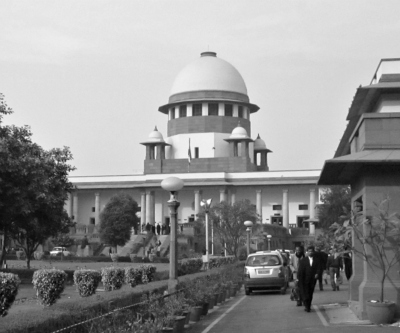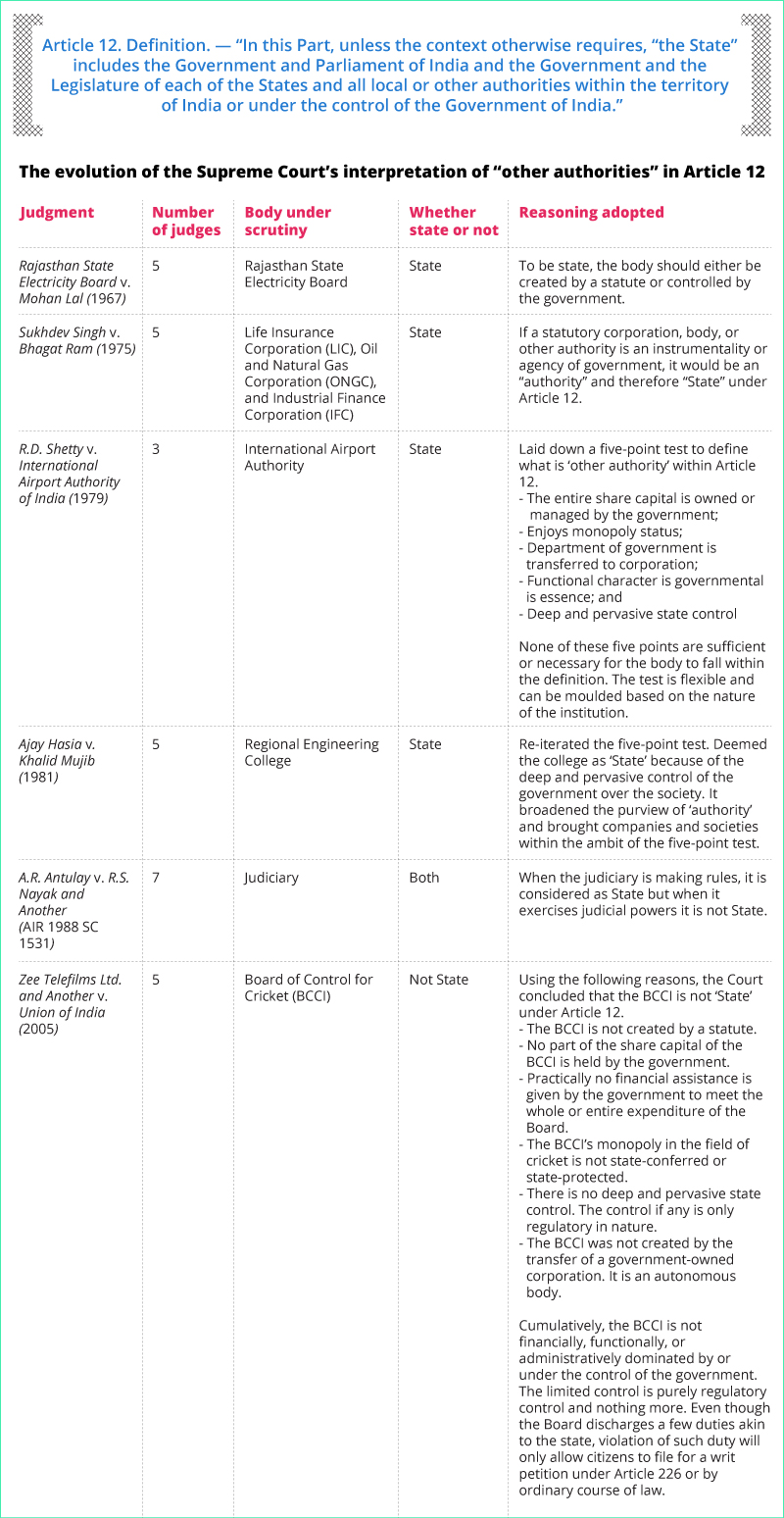Since Independence, there have been several special laws that have been used by both Union and state governments to acquire land  from private individuals. Many of them continue to exist. But, for more than a century, the Land Acquisition Act of 1894 has stood as the centrepiece of the Indian state’s policy of expropriation, used most frequently to acquire private property.
from private individuals. Many of them continue to exist. But, for more than a century, the Land Acquisition Act of 1894 has stood as the centrepiece of the Indian state’s policy of expropriation, used most frequently to acquire private property.
Viewed broadly, the 1894 statute canonised a power of eminent domain, which was thought to be a facet intrinsic to a sovereign. The law gave the authority to government to acquire private land for what the state perceived to be a public purpose, in exchange for a compensation, which, when determined under the process prescribed by the statute, was almost always grossly derisory.

The Union Minister for Rural Development in the UPA government, Jairam Ramesh (left), and Union Minister for Urban Development in the NDA government, Venkaiah Naidu, addressing press conferences on the land acquisition law in September, 2013 and March, 2015 respectively.
It also allowed the state the authority to acquire land unbothered by the economic and social impact that the acquisition might have on the landowner. The statute did not prescribe any social or environmental impact assessment as a precondition for expropriation, and it also imposed no obligation on the government to rehabilitate those displaced by the acquisition. The lack of any safeguards in favour of the landowner effectively meant that the poor person’s land was viewed as the sole property of the state, as property that could be subjected to legally sanctioned fraud and plunder. It was in this backdrop that in early 2014, the Right to Fair Compensation and Transparency in Land Acquisition, Rehabilitation and Resettlement Act, 2013 (“LARR Act”) was brought into force to replace the 1894 law.
The new act was designed to bring an end to a century-long form of oppression. It sought to define the public purpose, for which land could be acquired, with particular clarity; in cases where land was to be acquired for a private project, the consent of at least 80 per cent of the landowners was mandated; the state was barred from acquiring land for the purposes of establishing private hospitals and private educational institutions; a detailed social impact assessment (“SIA”) and an environmental impact assessment was mandated as a precondition to any acquisition; and, most crucially, compensation for lands acquired was to be fixed at four times the market value of the land, in cases where the property was situated in a rural area, and at two times the market value for properties situated in an urban area.
In all, the LARR Act, which was enacted on a largely bipartisan platform, was meant to usher an era of a more participative democratic process, where the people could have a genuine say in how their land is used. Unfortunately, these changes were far too short-lived.
Immediately upon assuming office, the Narendra Modi-led government criticised the LARR Act as a measure aimed at thwarting development. The premise of the new government’s argument was that expropriation of private property through powers of eminent domain stimulates economic growth, and brings about greater commercial expansion. The LARR Act, as they saw it, was simply antithetical to commonly understood notions of eminent domain.
Their solution, while awaiting parliamentary approval to amend the law, was to bring forth an ordinance. This ordinance, which amends the LARR Act, among other things, does the following. One, it removes a previous bar on acquisitions by the state for the purposes of establishing private hospitals and educational institutions. Two, it removes the necessity to secure the consent of landowners when property is acquired for the purposes of redistribution to private entities. Three, it eliminates the requirement for an SIA when land is acquired for a special category of purposes, including for the purposes of national security and the defence of India, and for purposes of establishing “industrial corridors,” and “infrastructure” projects.
As is plainly evident, the proposed amendments, which are presently in force through the operation of the ordinance, seeks to revert us to a slightly modified version of the 1894 law, by virtually removing the spine of the LARR Act. The changes amount, as G. Sampath, wrote in The Mint, to what the Marxist geographer David Harvey might have described as “accumulation through dispossession.” The question now is: would these changes, if ultimately enacted by Parliament, be constitutionally sustainable?
Eminent domain and the constitutional right to property
The Constitution of India, as originally enacted, on the one hand, guaranteed to citizens a right to property, while, on the other hand, implanted in the state an express authority to take property through an exercise of a power of eminent domain. Article 19(1)(f), subject to reasonable restrictions in the public interest, guaranteed to all citizens the right to acquire, hold and dispose off property. Article 31 provided that any acquisition of property by the state may be done only for a public purpose and upon payment of compensation, through a validly enacted law. What this meant was that once a person’s privately owned property was acquired by the state in accordance with Article 31, his or her right to hold the property subject to reasonable restrictions under Article 19 was rendered otiose.
In the earliest cases that emanated in post-Independence India out of the exercise by the state of its power to acquire property, the Supreme Court tended to view Article 31 as an embodiment of a power of eminent domain, which inheres in the state as a sovereign.
The term “eminent domain,” wrote Justice Mahajan in State of Bihar v. Kameshwar Singh, (1952) 1 SCR 889, could be traced back to the year 1625 and to the great jurist Hugo Grotius’s work, De Jure Belli et Pacis. “The property of subjects is under the eminent domain of the State, so that the State or he who acts for it may use and even alienate and destroy such property,” wrote Grotius, “not only in the case of extreme necessity, in which even private persons have a right over the property of others, but for ends of public utility, to which ends these who founded civil society must be supposed to have intended that private ends should give way. But it is to be added that when this is done the State is bound to make good the loss to those who lose their property.”
The meaning of eminent domain, in its irreducible terms, was, therefore, according to Justice Mahajan, (a) a “power to take” land (b) “without the owner’s consent,” (c) “for the public use,” after payment of compensation. In the initial years, the power, thus understood, seemed to impede the state in implementing its socialistically driven policies of expropriating land owned by zamindars more than it benefited it. Yet, as we have seen in the decades since, the very idea of viewing eminent domain as a power that is intrinsic to a sovereign has proved problematic. (Usha Ramanathan, “A Word on Eminent Domain”, Displaced by Development – Confronting Marginalisation and Gender Injustice).
Justice Vivian Bose, however, notably warned against using a “doubtful” term such as eminent domain to understand the Indian state’s power to acquire property. Doubtful, not because the term is “devoid of meaning,” but because it enjoys a different shade of meaning in different countries. “In my opinion, it is wrong to assume,” he wrote in Dwarkadas Shrinivas of Bombay v. The Sholapur Spinning & Weaving Co. Ltd., AIR 1954 SC119, “that these powers are inherent in the State in India and then to see how far the Constitution regulates and fits in with them. We have to interpret the plain provisions of the Constitution and it is for jurists and students of law, not for Judges to see whether our Constitution also provides for these powers and it is for them to determine whether the shape which they take in India resemble any of the varying forms which they assume in other countries.”
The final draft of Article 31, which constitutionalised the power of eminent domain, was arrived at purely through compromise. There were some in the Constituent Assembly who believed that land had to be usurped from zamindars, without payment of any compensation (or at any rate, by paying only a minimal, meagre amount) to help herald a more equal and just society, while there were others who argued for a strong protection of property rights, requiring the fulfilment of elements of due process prior to any expropriation. The ultimate provision, contained in Article 31, which was almost literally adopted from Section 299 of the Government of India Act, 1935, as Namita Wahi has pointed out, pleased neither group. It merely transferred the debate on the right to property to the court halls around the country. And, contrary to popular discourse, barring few instances where the courts have restrained Parliament’s powers, by objecting to specific acquisition laws, judges have predominantly allowed the state substantial leeway in exercising its power of eminent domain.
Amending the Constitution, protecting eminent domain from the courts

The Supreme Court of India
Yet, it was in fear of intervention by the courts that the First Amendment to India’s Constitution (whose validity was upheld by the Supreme Court in Sankari Prasad Singh Deo v. Union of India, AIR 1951 SC 458) was introduced in 1951, inserting not only Article 31A, which immunised land reform laws from challenges against violation of fundamental rights, but also Article 31B and concomitantly Schedule IX to the Constitution, which protected 13 particular legislation from challenge under Part III of the Constitution, with added retrospective effect. By virtue of these amendments, the crux of the challenge to the Bihar Land Reforms Act, 1950, which had been struck down by the Patna High Court, prompting the first amendment, was effectively rendered futile. Nonetheless, the Supreme Court, in State of Bihar v. Kameshwar Singh, (1952) 1 SCR 889, found that the Act, which sought to redistribute estates in Bihar, was based on a legitimate public purpose, and was therefore in consonance with Article 31.
Immediately after Kameshwar Singh’s case, the Supreme Court rendered a judgment, in State of West Bengal v. Bela Banerjee, AIR 1954 SC 170, which was significant in its elaboration of the importance of the right to property (Seervai, Constitutional Law of India), and which ultimately led to the Constitution’s Fourth Amendment. Here, a provision of the West Bengal Land Development and Planning Act, 1948 was challenged as violating Article 31, as it limited the compensation payable to the market value of the land as on December 31, 1946.
The word “compensation,” as used in Article 31, the Supreme Court ruled, referred to a “just equivalent of what the owner has been deprived of,” and, therefore it found that the provision offended the Constitution. As a result of this decision, Parliament introduced the fourth constitutional amendment and altered Article 31(2) to provide that a law under which compensation is determined for acquisition of land could not be questioned on the ground that such compensation is inadequate.
This amendment, as the legendary constitutional law scholar H.M. Seervai wrote, was considered in four different cases, P. Vajravelu Mudaliar v. Special Deputy Collector, Madras, AIR 1965 SC 1017, Union of India v. Metal Corporation of India, AIR 1967 SC 637, State of Gujarat v. Shantilal Mangaldas, AIR 1969 SC 634, and RC Cooper v. Union of India, AIR 1970 SC 564 (“the Bank Nationalisation Case”). Each of these cases contradicted the other on the issue of compensation under Article 31. Ultimately, it was the decision in the Bank Nationalisation Case, which was heard by a bench of ten judges, that proved most telling, rendering the fourth amendment’s purport nugatory, and reverted the law to the position established previously by the court in Bela Banerjee. The Supreme Court held in the Bank Nationalisation Case that the word compensation as used in Article 31, even after the fourth amendment, continued to denote a just equivalent of what the landowner had been deprived of. As had become common by now, when a court’s ruling tended to affect the ideology of the government in power, what resulted was a constitutional amendment: in this case, the 25th amendment.
Through this, Article 31(2) was altered, and the word “compensation” was replaced with the word “amount”; acquisitions under Article 31 were expressly removed from being subject to the right guaranteed under Article 19(1)(f), as was held in the Bank Nationalisation case; and laws giving effect to the directive principles contained in clauses (b) and (c) of Article 39 could no longer be questioned on the ground that they violated the rights guaranteed in Articles 14, 19 or 31.
Eventually, the Supreme Court in Kesavananda Bharati v. State of Kerala, AIR 1973 SC 1461, struck down the last limb of the 25th amendment alone. Here, a 13-judge-bench famously held that constitutional amendments could not be used as a tool to abrogate the basic structure of the Constitution: in this case, the power of the courts to judicially review Parliamentary law.
For the purposes of the right to property, though, it was Justice Khanna, whose opinion in Kesavananda proved the most decisive, that continues to resonate. He held that the right to property was not a part of the basic structure in his efforts to illustrate the fact that fundamental rights could, in limited circumstances, be annulled through constitutional amendment.
The jagged hole left by the 44th amendment
The decision in Kesavananda heralded an era of a battle between the government and the court over who holds the ultimate authority to interpret the Constitution. The give and take between Parliament and the Supreme Court may not quite have completely thwarted the state’s program to bring forth land reforms—if anything, the courts sought to place the odd impediment that they found was mandated under the Constitution.
But governments, impatient as they were, thought it necessary to bring forth a plethora of constitutional amendments aimed at placing land laws completely beyond the scope of judicial review. Ultimately, in 1978, the Janata Party, which had come into power following the Indira Gandhi-enforced Emergency, through the 44th constitutional amendment, removed altogether the guarantee of the right to property as a fundamental right. Both Article 19(1)(f) and Article 31 were completely obliterated. In their place, Article 300A was introduced, according the right to property the mere non-fundamental status of a legal right. These amendments, as Seervai argued, failed to grasp that Articles 19(1)(f) and 31 “were so closely interwoven with the whole fabric of our Constitution that those rights cannot be torn out without leaving a jagged hole…”
In the short run, the 44th amendment might have even helped in bringing forth more equivalence in land ownership, as desired by the government at the time. But, during the decades that followed, with an atmosphere of neo-liberalism taking over the Indian polity, the amendment has only contributed towards increasing discrimination. The power of eminent domain has been regularly abused to serve private interests. As Namita Wahi has pointed out, a number of measures have been introduced to place property at the hand of select institutions and corporations, often transcending constraints of public purpose contained in the original doctrine of eminent domain. (Namita Wahi, “State, Private Property and the Supreme Court”, Frontline).
For instance, “with the enactment of the Special Economic Zones Act in 2005,” wrote Wahi, “the acquisition of land by government to hand over to private industry which had happened in an ad hoc manner in previous decades became official government policy.” The meaning of “public purpose” has been expanded to absurd lengths, and different governments have overseen the most arbitrary expropriation of land, particularly from farmers, through the archaic, and draconian, Land Acquisition Act of 1894. These acquisitions have been rarely, if ever, disturbed by the courts, and even the compensation paid to individual landowners has been seldom enhanced.
What’s more, state governments also enacted their own special legislation to acquire land, bypassing, in the process, even the minimal safeguards contained in the central law.
Thus far, the Supreme Court has not ruled on the merits of the validity of the 44th constitutional amendment. It has only occasionally taken the pains to point out that the removal of the right to property from Part III has accorded substantial leeway to the state in expropriating land. (See for example, KT Plantation Pvt Ltd. v. State of Karnataka, (2011) 9 SCC 1.) Most of the Supreme Court’s decisions seem to indicate that it too has been equally buoyed by the supposed joys of liberalisation.
When viewed in this context, the LARR Act of 2013 represented a substantial breakthrough. It sought to realign the nature of property in India, by guaranteeing to citizens a right to own and hold land, which ought to ideally enjoy fundamental status. To the extent that it provided not only for an enhanced and more just compensation, but also for a social and environmental impact assessment, and for a voice to landowners, the LARR Act was a decidedly successful piece of legislation. It is therefore that the present ordinance, which seeks to remove many of the integral facets of the LARR Act, has to be considered as an anathema. To make things worse, by virtue of the 44th amendment, the state can today argue convincingly that the ordinance is legally valid and that it stands on substantial constitutional bedrock.
None of the diktats of the LARR Act, which have been removed by the ordinance, can be considered as constitutionally mandated, if we were to assume that the 44th amendment has accorded the state a carte blanche over private property, as some Supreme Court decisions seem to suggest. (See for example, Jilubhai Nanbhai Khachar v. State of Gujarat, AIR 1995 SC 142).
A historic re-interpretation of the Constitution is required
The state, unless convinced by the abiding public sentiment on the matter, would argue in the case of the proposed amendments: firstly, that the consent of landowners and the conduct of an SIA are simply not required as a matter of constitutional guarantee, and secondly that in the absence of an express prohibition of acquisition by the state for private purposes, the argument that the ordinance violates traditional notions of eminent domain, in allowing acquisition of land for private educational institutions and private hospitals, does not pass muster.
To negate such submissions, we would require the Supreme Court to shed its apathy, and to interpret the Constitution in its right spirit. The court will have to reconsider the understanding of eminent domain that has pervaded its jurisprudence, over the years. The removal of the fundamental right to property, by the 44th amendment, cannot be considered as a final nail in the coffin of rights over land.
To rebut the notion that eminent domain inheres in a sovereign, we might require an intervention that transcends mere judicial review, an intervention that is democratically justifiable. But what the courts can do is to examine Article 14, and the basic guarantee to the people of equal protection of the laws. Interpreted in its finest light, the right to equality ought to impose a superior obligation on the state to protect private property, and to give people a genuine say in how their land is used. To not hold so would negate the very idea of citizenship.
(Suhrith Parthasarathy is an advocate practising at the Madras High Court.)
 Two cases that the Supreme Court has been hearing during the last few weeks do not have anything to do with each other at first glance – the legality of the Aadhaar card scheme (“the Aadhaar case” – including Writ Petition (C) No 494 of 2012) and the constitutionality of the law of criminal defamation (the “criminal defamation case” – including Writ Petition (Crl) No 184 of 2014). Both are complex cases but my focus is on the contradiction about the right to privacy arising from the arguments made on behalf of the Union in both these cases.
Two cases that the Supreme Court has been hearing during the last few weeks do not have anything to do with each other at first glance – the legality of the Aadhaar card scheme (“the Aadhaar case” – including Writ Petition (C) No 494 of 2012) and the constitutionality of the law of criminal defamation (the “criminal defamation case” – including Writ Petition (Crl) No 184 of 2014). Both are complex cases but my focus is on the contradiction about the right to privacy arising from the arguments made on behalf of the Union in both these cases.





